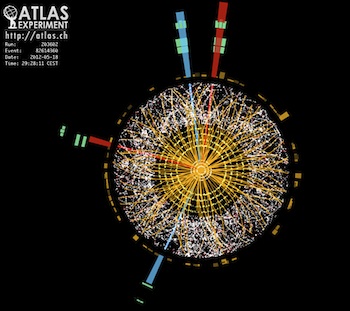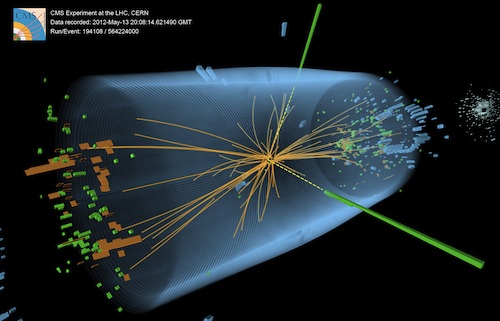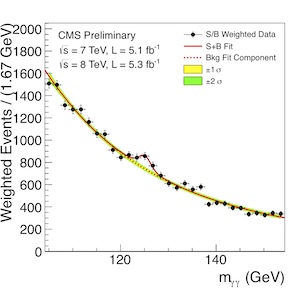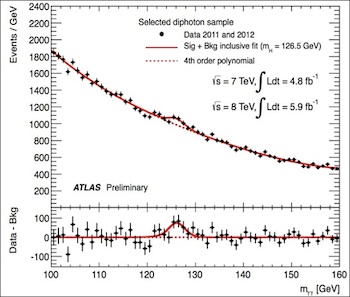If it looks like the Higgs... and it smells like the Higgs... have we finally found it? "As a layman I would say we have it," said Rolf Heuer, Director General of CERN. "Do you agree?" he asked the audience at the historic seminar this morning announcing the latest results from the Large Hadron Collider (LHC). The rapturous applause can only mean one thing – yes, we have finally observed the Higgs boson.

An event recorded by the ATLAS detector in 2012 showing the characteristics expected from a Higgs boson decaying into four electrons. (Image ATLAS)
Although they were being careful not to say definitively they had obseved the Higgs boson in the ATLAS and CMS experiments at the LHC, both teams announced they have indisputably discovered a new particle. It has a mass of 125-126 GeV and all its properties are consistent with the Higgs boson predicted by the standard model of particle physics. "They know they've found something that hasn't been found before," says Ben Allanach, a theoretical particle physicist and one of the many people who has been a part of this long search. "They know it's a particle and they are just being really strict [about saying what they've found]. It could be something else but all this particle's properties are consistent with a standard model Higgs boson."
Between April and June 2012 the LHC delivered more data than during all of 2011, and it's the results from analysing this data that were presented to the seminar today, webcast around the world. "We now have more than double the data we had last year," said CERN Director for Research and Computing, Sergio Bertolucci before the announcement. "It's a very exciting time." The data has come in far quicker than anyone expected. As Fabiola Gianotti, the head of the ATLAS experiment, said: "It's a miracle. We're operating beyond the design, beyond the expectations [of the LHC]." And this has meant they have been able to discover the Higgs boson far quicker than anyone, including Peter Higgs himself, dreamed. Higgs said at the end of the seminar: "For me the really incredible thing is that it's happened in my lifetime."

An event recorded by the CMS detector in 2012 showing the characteristics expected from a Higgs boson decaying into two photons. (Image CMS)
The Higgs boson is the missing link in the standard model of particle physics, a mathematical description of the fundamental particles and their interactions. Although phenomenally successful in most of its predictions, the standard model cannot explain why some of the fundamental particles have mass. The physicist Peter Higgs came up with a possible explanation in the 1960s, which predicts the existence of the particle that now carries his name. Finding the Higgs boson is one of the primary aims of the Large Hadron Collider, a 27km long ring-shaped tunnel in which protons are made to collide at extremely high energies. The idea is that these particle collisions would produce the Higgs boson, if it does exist. (You can read more about the Higgs boson in our article Particle hunting at the LHC.)

The data from the CMS detector for decays into two photons. The bump at 125-126GeV indicates the presence of the new particle. (Image CMS)
Physicists could not hope, however, to see the Higgs boson directly, as it decays into other particles immediately. It is the properties and behaviour of the particles it decays into that can be detected by the ATLAS and CMS experiments at the LHC. Using the standard model, which doesn't include the Higgs boson, it is possible to predict what the data collected by the LHC should look like as a result of the behaviour of all the other particles in the standard model (referred to as the background in the presentation today). And if the actual data looks different from the predicted background data in the right way (if it agrees with the predictions of the standard model plus the Higgs) then that counts as evidence that the Higgs does exist. (See the Plus article Countdown to the Higgs for more detail.)
Such indirect observations don't give us 100% certainty of course, so physicists quantify their certainty using sigma levels. Today's evidence weighs in at the five sigma level for both the ATLAS and CMS experiments. This means that the chance that ordinary background processes that do not involve a Higgs fluctuate by the amount seen is only about one in 3.5 million.

The data from the ATLAS detector for decays into two photons also shows a peak at 125-126GeV, further proof of the presence of the new particle. (Image CMS)
Today's evidence shows that a new particle has indeed been discovered, but physicists won't rest easily until more analysis has confirmed it as the Higgs boson described by Higgs' theory or if it's a new exotic particle. "It's a bit like spotting a familiar face from afar," said CERN Director General Rolf Heuer. "Sometimes you need closer inspection to find out whether it's really your best friend, or actually your best friend's twin." And if it does turn out to be a sibling of the Higgs then we will need new physics to account for it.
According to Allanach, however, we can be sure we've found a Higgs boson-like particle. And excitingly, the slightly unexpected results for one mode of decay, where the Higgs boson decays into two photons, might indicate something new... another new particle in addition to the Higgs. "The decay into two photons is the most egregious channel," says Allanach. "ATLAS found the frequency of excess photons produced to be twice that expected by the standard model Higgs. The errors are large so this could just be a fluke. Or it might mean that something else is going on, for example an additional new particle involved in Higgs decays, making the Higgs decay more frequently into two photons. This would then be the even more exciting discovery of both the Higgs and another new particle, for example one predicted from supersymmetry theory."
Allanach described the mood at the Cavendish Laboratory where he watched the webcast of the seminar: "It was amazing. It was silent, everyone was concentrating very hard. We were really excited and we were also frustrated. We just wanted to see the slides and the data." For many physicists it's clear that rather than an ending this discovery is just the beginning of an exciting new era of research.
The scientific seminar was clearly an emotional moment for everyone involved. You could hear the excitement in the voices of the two speakers, Joe Incalda from CMS and Fabiola Gianotti from ATLAS, and wild applause, standing ovations, hugs, kisses and tears greeted their results. So now it's time for everyone involved – including the mathematicians and theoretical physicists who built the models and analysed the results, the physicists who devised and ran the experiments and the technicians and engineers who built the LHC – to open the champagne. It is a historic day and congratulations to all of you on a magnificent acheivement!
To find out more about the theoretical mechanism devised by Peter Higgs, read the Plus article Secret symmetry and the Higgs boson.